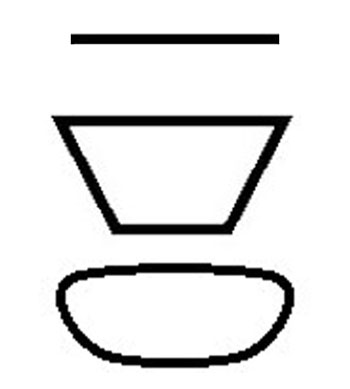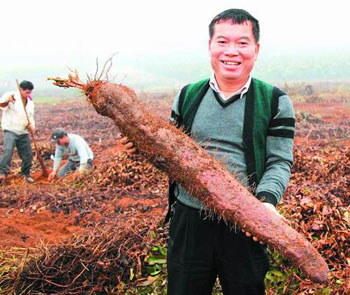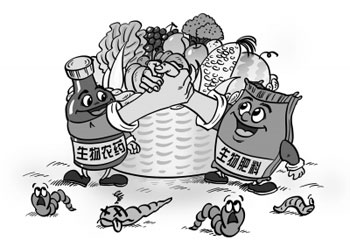The wonderful effect of the new water-retaining component of "saving water and losing weight"
Original title: in addition to drip, sprinkler irrigation facilities and plastic film mulching, there is a new choice of water conservation components for the implementation of water and fertilizer integration.
Try to transfer the effect of "saving water and losing weight" to Daejeon.

Flake, basin, bowl
Water-retaining member
Water control and controllable fertilizer is a bright spot of water and fertilizer integration technology, so how can water and fertilizer integration be implemented in areas lacking drip irrigation, sprinkler irrigation facilities and plastic film mulching? In recent years, Professor Liao Zongwen of the New Fertilizer Resources Research Center of South China Agricultural University has led his team in technological innovation, processing water-retaining agents and fertilizers into water-retaining components to achieve the goal of saving water and fertilizer in the field on the premise of promoting the healthy growth of crops. Today, this edition invites him to introduce this new product to you.
Improving the use efficiency of water and fertilizer is the intersection of the two strategic goals of water-saving agriculture and improving fertilizer use efficiency.
At present, the water-retaining agent on the market is made of acrylic acid and acrylamide as the main raw materials, and the price is as high as 20,000 yuan per ton. The market price of commercial water-retaining agent per ton is generally more than 20,000 yuan, and the salt resistance is poor, and the fertilizer retention capacity is not strong. It is not conducive to popularization and application in the field.
In recent years, the New Fertilizer Resources Research Center of South China Agricultural University has successfully developed a series of composite (mixed) water-retaining components made of organic-inorganic composite water-retaining materials, which are made of 30% mineral materials and biomass materials. the cost is reduced by 30%, but the water retention performance is basically unchanged, and the salt tolerance and fertilizer retention performance is improved. It can be said that the water conservation component turns the control measures of the separation of water and fertilizer into the technical carrier of the integrated regulation of water and fertilizer, which is a new product besides drip irrigation, sprinkler irrigation and plastic film mulching, and is one of the carriers of the integration of water-saving and fertilizer-saving technologies in our country for many years.
Water retention capacity:
From water absorption and water support
What are the main sources of water retention of water-retaining components?
One is the water absorption of the water-retaining material, which can absorb hundreds of times its own weight of water, and its reticular structure can retain a lot of water, which can be slowly released to the soil for root absorption when the soil is dry, similar to the water absorption of the sponge, but a hundred times stronger than the sponge. Why can water-retaining materials regulate the release of fertilizer nutrients? Because the release of fertilizer nutrients is mainly achieved by the movement of water, fertilizer goes with the water, water movement is fertilizer movement, and water control can control fertilizer. Therefore, the water-retaining agent achieves the purpose of regulating fertilizer by regulating water at the same time, so as to realize the integrated regulation of water and fertilizer.
The second is the water-holding capacity of water-retaining components, which stems from the water-holding capacity produced by the spatial configuration of water-retaining components (flake, basin and bowl-shaped components) to intercept and support the water movement of the soil layer (mainly to block water infiltration and lateral infiltration). The water (nutrient solution) is retained in the soil layer, which obviously improves the effect of water conservation and fertilizer conservation. It is different from the water-retaining effect produced by water-retaining agent through water absorption, it is a new water-retaining mechanism and technical research and development idea, and has outstanding advantages. In general, the water-retaining effect of water-retaining agent only comes from a single water absorption, while the water-retaining effect of water-retaining components comes from two aspects, that is, not only the water absorption, but also the water-holding capacity obtained after the configuration. In this way, acting together with water absorption, the effect of two-pronged water absorption is obviously better than that of single water absorption. This is the unique advantage of this technology. In addition, cheap materials such as mineral powder, sawdust and straw with weak water absorption can be added to obtain higher water retention and further reduce the cost.
The dosage of water-retaining agent is about 3 kg per mu and the cost is about 50-60 yuan. The water conservation component can reduce leaching loss and save fertilizer by more than 20%, so it can become an effective technology to control non-point source pollution with low cost and good effect, and has strong maneuverability.
Integration of water and fertilizer:
It can work all the year round.
Compared with the mixed use mode of water-retaining agent and soil, the water-retaining component with spatial configuration can have better water absorption capacity and water-supporting capacity at the same time, and the effect of water and fertilizer conservation is further improved, so the yield-increasing effect is better. And there is a higher water content in the soil after harvest. In general, the use of water-retaining agent can save 25% of water and 20% of fertilizer, while the output does not decrease or increase, and the technical and economic advantages of water-retaining components are obvious in production.
For example, under the same fertilization condition, the diameter and volume of eucalyptus increased more than twice in one year, but the cost of water-retaining components was only 0.1-0.2 yuan per plant. After one year of application of water conservation fertilizer (equal amount of nitrogen, phosphorus and potassium) in Weihua eucalyptus base in Qingyuan City, Guangdong Province, the diameter of the treated tree was increased by two times, and the cost was only 0.1 yuan.
The treatment of water retention components increased the survival rate, ground diameter, leaf water content and chlorophyll content of Camellia oleifera seedlings. The survival rate of Camellia oleifera seedlings in the control group was only 60%, while the water retention component treatment increased to 90% to 100%, the total chlorophyll of leaves increased by more than 30%, the ground diameter increased by more than 23%, and the relative water content of leaves was 4% higher than that of the control.
Water conservation components have obvious effect on water conservation and fertilizer conservation of sugarcane, banana and other crops in the south, which can reduce the loss of nitrogen, phosphorus and potassium nutrients and enhance crop resistance. Under the condition of water shortage and low temperature, the survival rate of banana and sugarcane seedlings was significantly higher than that of the control, increasing by 40%, generally increasing production and reducing cost.
Water conservation components have obvious technical advantages and broad application prospects. Practice has proved that the function of water-retaining components can preserve not only water, but also fertilizer. Therefore, the water-retaining agent can play a role all the year round and play an important role in the northwest arid area and the southeast coast. Water conservation is given priority when there is little drought and water, while big Rain Water is mainly fattening when there is much drought. In the southern summer rainstorm season, due to the reduction of nutrient loss washed by Rain Water, the effect of fertilizer conservation is particularly prominent. It breaks through the seasonal and regional limitations of the application of water-retaining agent, develops a new concept of time and space in the application of water-retaining agent, and provides a new technical means for the integration of water and fertilizer.
In addition to being used in general farmland, water conservation components can be used in desert vegetation, highway slope vegetation, garden matrix, golf course and so on, with obvious advantages and broad market prospects. (Liao Zongwen, professor, School of Resources and Environment, South China Agricultural University / photo)
- Prev

Wechsler's rice milling technique for grain security is divided into three steps
Wechsler's rice milling technique for grain security is divided into three steps
- Next

Biological fertilizer hand in hand to cure both the symptoms and root causes of diseases and pests
Biological fertilizer hand in hand to cure both the symptoms and root causes of diseases and pests
Related
- A course of planting techniques and methods on how to grow carrots
- How to plant the latest tulips?
- Is it better to pick tea in the morning or in the afternoon? When is the best time for tea to be picked? what is the third or fifth tea?
- Launch Yuanxiao Happy combination Haocha + Tea Yuan healthy Taste
- Penghu Tourism "Fireworks 20 Parade with You"
- 2022 West Lake Happiness holds "Digital Revitalization Voucher" and draws iphone13 and laptop.
- Banqiao Fuzhou social houses are designed to change start-up combined with police elimination to create a safe and livable environment
- The convenient measure of "mechanical weeding" in Xinbei has been abused and the Agriculture Bureau has imposed heavy penalties on the illegal land consolidation.
- Changgeng University Joins Hands with Four Memory Factories to Rescue Memory Talent Shortage
- The list of Taiwan's top 100 MVP managers is listed by the Director-General of the Farmers' Association of Sanxia District.

